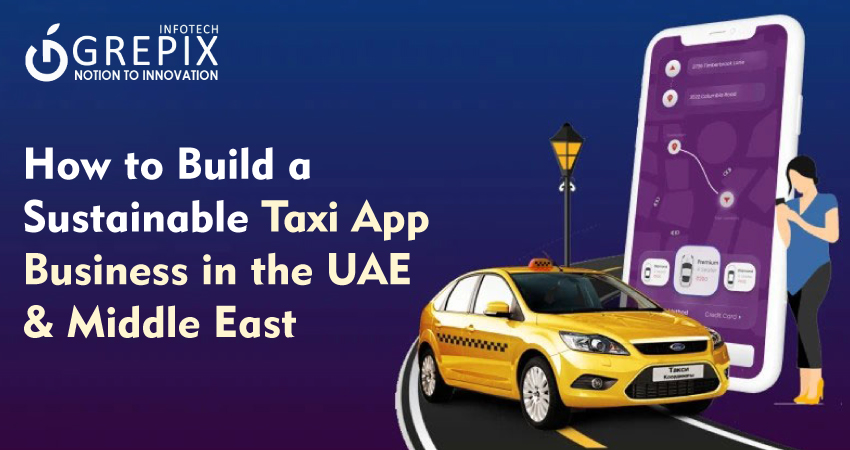How to Build a Sustainable Taxi App Business in the UAE & Middle East
The ride-hailing market in the UAE and the wider Middle East is booming, expected to reach a market valuation of $12.4 billion by 2032, growing at a CAGR of 13.4% from 2024 to 2032. With over 4 million users projected in the UAE alone by 2028, the demand for taxi app development UAE solutions has never been higher. This surge is fueled by urbanization, high smartphone penetration, and supportive government initiatives fostering a digital and sustainable transportation ecosystem. Aspiring entrepreneurs can capitalize on this with smart, compliant, and innovative taxi app solutions that can compete as an Uber alternative Dubai or as thriving ride-hailing startups UAE.
Starting a sustainable taxi app business in the UAE and Middle East involves navigating licensing, understanding costs, leveraging regional features, ensuring user safety, and integrating secure payments. The market is growing rapidly, driven by government support for smart cities, tourism, and tech-savvy users. This blog will provide a detailed, SEO-optimized guide targeting taxi app development UAE, Uber alternative Dubai, and ride-hailing startup UAE, designed to rank high on Google and serve both transactional and informational search intent.
The UAE and Middle East offer a thriving market for taxi app development with rapid growth driven by technology and government support. To build a sustainable taxi app business, understanding licensing, regional preferences, costs, and safety measures is key. From securing RTA permits to integrating AI dispatch and payment systems, entrepreneurs must navigate complex but rewarding challenges. Success stories like Careem demonstrate the value of safety-focused features and multi-payment options. This comprehensive guide equips startups to launch a competitive Uber alternative Dubai and ride-hailing startup UAE, tapping into a market projected to reach $12.4 billion by 2032.
1Licensing Requirements for Taxi App Startups
Understanding Licensing in the UAE
To legally operate a taxi app in the UAE, obtaining the correct licenses is essential. The Roads and Transport Authority (RTA) in Dubai and corresponding authorities in other emirates regulate ride-hailing services. Licensing requirements include registering the company, getting vehicle permits, driver licenses, and ensuring compliance with safety and operational standards.
Key Documentation
- Business incorporation certificate
- Taxi service permit from RTA or relevant emirate
- Commercial vehicle insurance and third-party liability coverage
- Driver medical coverage and valid UAE driving licenses
- Compliance with data protection laws (UAE PDPL)
- Liability and business insurance policies
Each emirate may have unique compliance rules, so companies expanding cross-emirates must navigate multiple licenses or permissions.
2Costs Involved in Building a Taxi App Business
Breakdown of Key Expenses
Starting a ride-hailing startup UAE requires a budget typically between AED 1.2 million to 2 million, covering:
- App development (custom or white-label solutions)
- Licensing and registration fees
- Vehicle acquisition or leasing
- Driver recruitment and training
- Marketing and customer acquisition
- Ongoing regulatory compliance and insurance
Taxi app development UAE costs vary based on features and platform complexity. A simple app starts lower, while AI-powered dispatch and multi-service integration raise costs. However, choosing white-label taxi apps or MVPs (minimum viable products) can reduce initial investment.
3Regional Features Unique to the Middle East Market
Technology Trends
- AI-Driven Dispatch: Optimizes driver allocation, reducing wait times and fuel consumption.
- Super Apps: Combining ride-hailing with food delivery, payments, and more (e.g., Careem).
- Robotaxis and Autonomous Vehicles: Pilot projects in Abu Dhabi and Dubai target 25% autonomous transport by 2030, signaling future integration.
Cultural and Market Preferences
- Preference for safe, reliable, and affordable rides using standard cars, which dominate 65% of the market due to cost-efficiency.
- Multi-payment options including cash, card, Apple Pay, and e wallets tailored to user convenience.
- Emirati and expatriate user base expect services in multiple languages and high app responsiveness.
4Ensuring User Safety in Ride-Hailing Apps
User safety is paramount and a strong differentiator in the UAE market.
Essential Safety Features
- Driver Verification: Background checks, photo validation before rides.
- Real-Time Tracking & Ride Sharing: Passengers can share their ride details with trusted contacts.
- SOS Button: Immediate alert to authorities or emergency contacts in danger.
- In-App Calling & Call Masking: Protects driver and passenger privacy.
- 24/7 Support: Quick resolution of complaints and issues.
- Case Study: Careem
Careem enforces strict driver vetting, in-app SOS features, and continuous monitoring, contributing to its position as a trusted Uber alternative Dubai.
Also Read: "Top Features That Make a Taxi App Stand Out in 2025"
5 Payment Systems and Monetization
Payment Integration
- Seamless, secure payments are critical for customer trust and operational efficiency.
- Support multiple payment methods: Cards, cash, mobile wallets, NFC payments.
- Implement transparent fare calculation with dynamic pricing during peak hours.
- Enable fare-splitting for carpool rides to promote affordability and sustainability.
Revenue Models
- Commission from each ride
- Surge pricing during high demand
- Subscription plans for frequent riders
- Advertising and partner integrations within the app
Step-by-Step Guide to Launching a Taxi App in the UAE
- Conduct thorough market research to identify gaps and user needs.
- Develop a detailed business plan including service model and technology stack.
- Obtain all required licenses and permits (consult RTA and emirate-specific rules).
- Choose app development approach: custom build or white-label solution.
- Recruit and train drivers, focusing on safety protocols.
- Implement AI-powered dispatch for efficiency.
- Launch a pilot in a small area to collect user feedback.
- Roll out full-scale marketing and user acquisition campaigns.
- Continuously monitor KPIs such as wait time, retention, and user satisfaction.
- Plan for scalability and expansion into other emirates or Middle Eastern countries.
Conclusion
Building a sustainable taxi app business in the UAE and Middle East requires a strategic blend of regulatory compliance, technology innovation, user safety, and efficient payments. By focusing on obtaining the right licenses, managing costs smartly, incorporating regional market features like AI dispatch and super apps, and prioritizing passenger security, entrepreneurs can launch viable Uber alternative Dubai concepts or successful ride-hailing startups UAE. The opportunity is tremendous, with market valuations projected into the billions, propelled by government support and a tech-savvy population. Now is the time to act start your taxi app development journey and carve your place in this fast-growing sector. Share this guide to help other innovators join the ride-hailing revolution.
FAQs
1. What licenses are needed to start a taxi app business in the UAE?
Licenses from the RTA or local transport authorities are mandatory, including vehicle permits, commercial insurance, and driver licenses. Compliance with UAE personal data laws is also required.
2. How much does taxi app development cost in the UAE?
Costs typically range from AED 1.2M to 2M, encompassing app development, licensing, vehicle fleet, marketing, and driver training.
3. Is building a custom app better than using a white-label solution?
Custom apps offer flexibility and unique features but cost more and take longer to develop. White-label apps are faster and more affordable for startups.
4. How can ride-hailing apps ensure passenger safety?
By implementing driver background checks, real-time tracking, SOS buttons, and 24/7 support to rapidly address issues.
5. What payment methods should a taxi app in the UAE support?
Multiple methods including credit/debit cards, cash, mobile wallets, and in-app wallets to suit diverse user preferences.
Launch your vision with our mobile app development company, where innovation meets excellence to create cutting edge mobile solutions.







